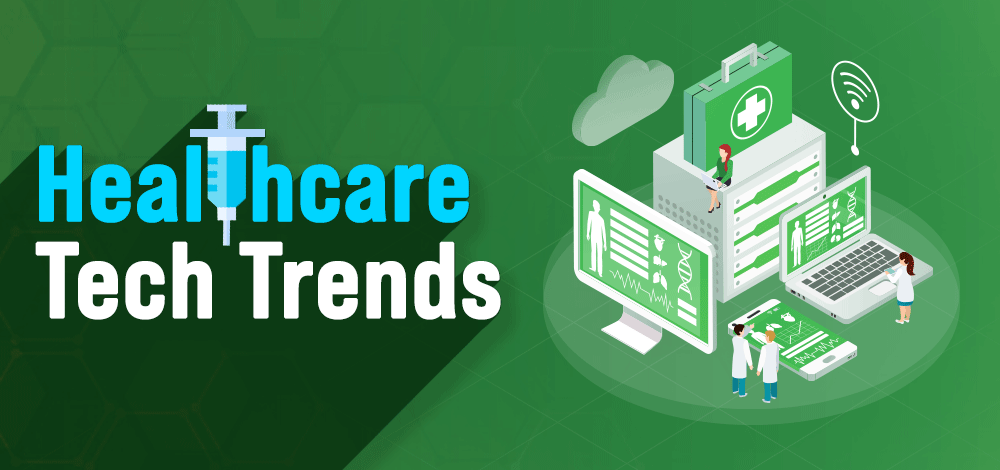We have witnessed in the past couple of years how badly COVID-19 hit the market and was declared a global pandemic. This situation forced everyone to go beyond and try out some innovative ways so that businesses could run, and it defined the setbacks and lack in the healthcare industry.
Considering this challenge, the healthcare industry is now all set to make more investments by aiming to increase the workforce and investment in digital healthcare technologies in the next 4–5 years. In the world of digitalization, we are aiming to make our lives better and more efficient. Now is the time to highlight some of the best digital foundations that can change the healthcare system and the way we used to see it earlier, and for that, we curated the 5 best healthcare tech trends that we need to watch out for in 2024.
7 Best Healthcare Tech Trends in 2024
In 2024, technological developments will transform the way healthcare is given around the world. Healthcare technology, ranging from generative AI to IoT powered hospitals, is a rapidly changing field which fuels innovation.Future healthcare technology trends are likely to introduce new amazing capabilities as well as strategic advancements. With these considerations in mind, let us see the 7 Best healthcare tech trends in 2024.
1. Generative AI in Healthcare
Generative AI will open up access to other transformational AI applications, making it easier to execute, interpret, and generate personalized suggestions. It will generate synthetic data that can be utilized to train medical AI algorithms without compromising patient privacy or in situations where there is insufficient relevant real-world data. It can also construct chatbots and virtual assistants to support patients at all stages of their journey.
The most advanced uses are in genomics, where AI is used to examine patients’ DNA to detect and treat diseases, as well as to design medicines that are tailored to specific people at the molecular level (also known as precision medicine). The applications of generative AI in healthcare are virtually unlimited, and we’ll undoubtedly return to it as we cover the other developments on this list.
2. Internet of Medical Things (IoMT)
You must have heard about IoT so far, but IoMT is slightly different in that it is used for connecting healthcare devices with the Internet along with the applications used within. In the past, when pandemics made everything difficult for almost every sector, virtual hospital wards are an example of this trend in action in 2024, when a single site serves as a center for monitoring several patients in their own homes.
The architecture of IoMT enabled certain crucial phases that include patients’s live monitoring, screening, remote monitoring, and treatment using telehealth (the use of digital information and communication technologies to remotely access healthcare services). Besides this, the future is bright for IoMT, and currently, the market is at $50 billion and is expected to go beyond USD 516.40 billion by the year 2032. Thanks to the smart innovators and companies who have been working tirelessly to make it work smoothly with less or almost zero error.
3. Smart wearable devices
The COVID-19 pandemic gave a warning for personal health, coinciding with the rise of remote work. The pandemic storm fueled a surge in smart wearable devices, allowing people to stay active and monitor vitals like heart rate, blood pressure, and even blood oxygen. These features not only provide real-time insights but also offer early detection of potential health issues.
The future of wearables in healthcare is bright, with estimations predicting a market explosion from $116 billion to $265 billion by 2026. We can even expect them to play a crucial role in clinical trials, providing continuous physiological data for faster drug development and earlier anomaly detection. Smart wearable devices will change healthcare by giving people and researchers the tools to monitor health and possibly make overall health better.
4. Virtual Reality (VR)
Virtual reality has been in trend for a while now, and this is turning out to be a lifesaver by offering new life-saving techniques to provide assistance for treatment. Although this field is relatively new, it has a great positive effect on patients and doctors. Currently, there are a handful of companies (Osso VR and Immersive Touch) that are offering to train doctors and surgeons to brush up their skills and practice new methods of treatment, and another report suggested that virtual reality has enabled a massive growth of +200% in terms of performance rather than applying the traditional methods.
Thus, VR is capable enough to eliminate the margin of error and could be a great asset for learning in the healthcare domain. This was just one of the applications for VR; besides this, it can also be used for conducting conferences and treating patients in a newer way by offering them VR-rich therapies. The market is welcoming VR in a positive way and has been continuously rising, resulting in it being likely to be worth USD $21 billion in 2025.
5. Remote Patient Monitoring (RPM)
Doctors are new methods to monitor patients without requiring them to visit the hospital. This is known as remote patient monitoring solutions. They employ sophisticated gadgets, like as smart watches, to measure heart rate and movement in patients.The information is then forwarded to the doctor, who can determine whether anything is wrong. It’s like having the doctor check on you while you’re at home. This allows people to receive care faster and more easily.
Remote Patient Monitoring (RPM) helps patients because they do not have to come to the hospitals for regular check-ups, which saves them time and money, especially for ongoing health issues. Various devices, like scales, oximeters, glucose meters, blood pressure monitors, and heart monitors, can be used to keep track of the health of the patients.
6. 3D printing
3D printing is making a big difference in healthcare. In places where medical equipment is scarce, it can be used to create tools and devices when needed, such as surgical instruments, implants, and prosthetics. Researchers are also exploring the possibility of 3D-printing organs for transplant using the patient’s own biological tissue. If successful, this could address the shortage of organs for transplant and significantly lower the cost of these procedures.
3D printing can change how doctors learn and plan surgeries. It helps make detailed models of the body from patient scans. Surgeons can touch and see these models before surgery, making it easier to plan. This makes surgeries more precise and lowers the chances of problems during the procedure.
7. Surgical robots
The use of surgical robots in operations is becoming more prevalent as they become more common in operating rooms worldwide. . Some surgical robots are already linked to AI platforms, improving surgical decision-making. In the future, we can expect more surgical robots with advanced AI capabilities. Moreover Surgical robots are likely to include augmented and virtual reality technologies, especially for surgeon training. This signifies a growing trend towards enhanced technology integration in the field of surgery.
Surgical robots offer exceptional precision and accuracy, allowing for delicate and intricate procedures. The robotic arms can make precise movements that may be challenging for human hands, leading to improved outcomes. The surgeries performed by surgical robots provide great accuracy, allowing for delicate procedures. The robotic arms can make precise movements that may be challenging for human hands, leading to improved outcomes such as shorter recovery times, less pain, and lower risks of infection for patients.
Must Read
Conclusion
The healthcare tech sector has been drastically booming at an enormous rate over the past few years, and sooner or later it is going to be our new normal with more improved and reachable technologies. This is just the beginning of a purely evolving digital world; the list of the best health tech trends isn’t finished here.
In fact, there are other technologies and devices too, like biopatch, telemedicine, digital prescriptions, digital therapeutics, and so on, that are helping in the health tech sector, but we move with the trend on what’s going to dominate in technology, and that’s why we’ve given you the list of the 7 best health tech trends to watch out for. As we move forward, we’re likely to see some more fascinating methods in the field of health technology, for sure.
FAQs
Why healthcare industry is investing in digital healthcare technologies?
The challenges posed by the COVID-19 pandemic highlighted the need for innovative solutions, forcing increased investments in workforce and digital healthcare technologies .
How does Generative AI help in healthcare, with regards to genomics?
Generative AI helps by creating and understanding personalized suggestions. Generative AI can diagnose diseases by examining a patient’s DNA at the smallest level.
What is the Internet of Medical Things (IoMT) important in healthcare ?
Internet of Medical Things (IoMT) links healthcare devices to the internet, allowing important tasks like monitoring patients in real-time, screening, remote monitoring, and telehealth.
What role smart wearable devices play in healthcare?
Smart wearable devices provide real-time insights but also contribute to early detection of potential health issues.
What positive changes does virtual reality (VR) bring to healthcare?
In healthcare, VR provides life-saving methods, improves training for doctors and surgeons, and is used in conferences and therapy.





